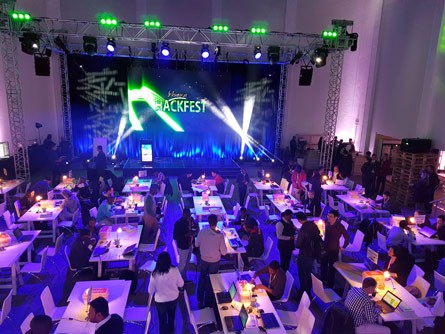This week we are showcasing what Standard Bank is doing around innovation. The stars of the show are Germaine Schmidt, Justin Walker and every participant of the 2017 Woema Hackjam.
The Woema Hackathon
The Woema Hackathon has become at Standard Bank, with its emphasis on Agile development, New Ways of Working and digitization.
This year’s Woema Hackathon, to be held at Galleria in Sandton, South Africa, is unusual in a few ways. The most significant change is that Personal and Business Banking (PBB) and IT are collaborating to solve a number of predefined business challenges facing their customers that have arisen through their New Ways of Working (nWOW) laboratories. These laboratories exist to improve the experience of customers.
Groundbreaking
The PBB element of this year's Woema Hackathon is called “Hacktegory 1”, and challenges participants to “Solve IT”. There are two additional Hacktegories: “Dream IT”, which asks for “solutions that might benefit the customer, the bank, or you as an employee”; and “Showcase IT”, which asks for “a pet project that you are working on in your spare time – banking related or not”.
“Traditionally we crowdsource ideas from IT,” explains Germaine Schmidt, IT Innovation Manager, “but this year, we are including PBB’s nWOW channels in the hack. Across all three categories, special points will be given to ideas which encompass the Internet of Things.”
Business involvement
The idea behind PBB’s involvement in what is traditionally an IT event is to get business involved at ideation level. Business’s participation in the hack makes it easier to adopt ideas, and allocate seed funding to take them forward. The Kidz Banking App, which was created at our first Woema Hackathon, took two years to deliver because it was a business idea born out of IT, as opposed to an IT idea borne out of business.
Business’s participation is also critical because we have specific problems that have been identified in our nWOW laboratories that need to be solved.
“Our laboratories have a backlog of problems they want to solve that they are not currently working on. They have given us a problem statement. We have to translate what they have given us into something IT can understand, and something that is fun,” Germaine says. “It’s a great opportunity to demonstrate how IT delivers value to our customers, over a fun and exciting 48 hour period.”
Preparation
Although only about 45 ideas make it through to the final event, the Hackjam starts long before the official 48 hours of development. Two months before, a brief goes out to IT, calling for teams of volunteers. Ideally, these teams should have a balance of engineering and presentation skills.
Teams are put together and ideas submitted, starting in May. This is combined with regular one-hour sessions in design thinking to assist participants develop “human-centred design, or designing from the customer backwards”.
“Design thinking is about putting yourself in the customer’s shoes, identifying different users, interviewing them, and using intelligent data. In other words, we are encouraging teams to research their products with customers before coming to the Woema Hackathon. They should have a storyboard ready and know what minimum viable product they are going to work on the day,” says Justin Walker, Lean & Agile Coach, as well as a core Woema team member.
“In the past, we said: ‘Here’s a problem. You aren’t allowed to do anything. Rock up on the day, and start working on it’. Now, we are saying, ‘You can do as much or as little as you like prep-wise before the day, you can come and spend those two days fine tuning and testing, as long as you have something to demo on the second day’. We are a lot more open to people doing pre-work.”
What do the organisers aim to achieve at the end of the 48 hours? “In the case of the first two hacks, we would like to see digital prototypes emerge,” Justin says. “Forty eight hours is not enough time to create something useable that can go into production. July, August and September is the final Dragon’s Den, where participants refine their coding. Ultimately, we will chose a winner.”
Application rationalization and Rasberry Pi
Two ideas came through from last year’s Hackathon. Both have had a big impact on efficiency and costs. The first, titled: Applications Rationalization, aimed to find applications in the bank which could be decommissioned or rationalized, in order to simplify our IT landscape.
The team of three business analysts and a project manager worked closely with Microsoft Office 365 to leverage a tool we already owned called Power 3 to make our IT capacity utilization more transparent to Chief Information Officers. It helped us to rationalize and decommission 76 applications and 800 servers in 2016, saving the bank about R194 million.
It also resulted in more collaboration between Microsoft and Standard Bank, with the team flying as far as Redmond, Washington, to work on the product with Microsoft, and discuss ways to take the collaboration further.
The second idea, titled: Rasberry Pi Solution, involved the team buying a couple of Rasberry Pis and inviting staff to play with them for two days. A Rasberry Pi is a tiny microcomputer usually used for educational purposes.
Justin explains the idea as follows: “In our bank’s command centre, where we monitor all of its infrastructure, applications, and so on we have about 24 screens which monitor everything from internet banking to batch monitoring to make sure our operations stay up and running.
“We were pricing a piece of software from an external vendor, which wanted R1.6 million to install the software and manage it remotely. It meant having a dedicated computer behind every single screen, and when it was being upgraded on the weekend, all the machines would be down.”
The team put a Rasberry Pi behind every screen and built a centralized piece of software which allowed it to control remotely what it wanted on every screen. It could log everything in at the push of a button. There were no ongoing maintenance and licensing costs. And, instead of paying R7000 to R9000 a PC, the project involved a once-off cost of R800 per Pi.
Once again, implementation was part of the success story. “We bought the equipment, installed it and then looked at how we could use it,” Justin says. “The whole process took three months. It probably would have taken two years to do it the other way around.”
The Rasberry Pi Solution has since been implemented at Stanbic Zambia’s primary production and disaster recovery sites. Mauritius, Lesotho and Swaziland are also showing an active interest in pursuing this low cost solution.
Innovation culture
Once again, this year’s Hackathon is as much about fostering a culture of innovation at Standard Bank as it is about creating new products and implementing them.
“There is a big difference between a manager going to a team and saying, ‘Solve this idea, or please do this for me’ and us saying, ‘Here’s an idea, if you are passionate about it, come up with a way to solve it’. Now, people want to solve the problem,” Justin says, pointing out that the Hackathon has intangible benefits for employee engagement and teamwork.
“All of the participants excel in their own way,” Germaine says. “It’s not just about implementation, it’s about the fact that they were noticed for their skill, innovation and capability. We encourage people to take things forward. It’s all about culture. It’s about changing the way you think, changing small things, doing things differently, and coming up with short term solutions that can translate into bigger solutions. Woema enables all of this. It takes commitment, perseverance and passion. We provide the opportunity, the forum to play with technology that isn’t always available to us. Woema is an excellent initiative. Its benefits are intangible.”
From Langerman Panta Rhei good luck to Germaine and her team and all the participants at the Standard Bank Woema Hackathon 2017.

